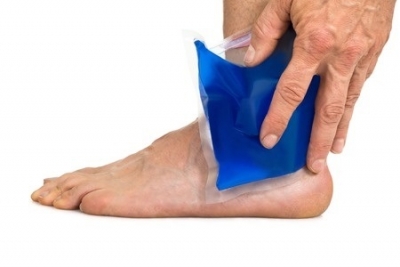Connect With Us
Blogs

Ankle Care (6)
At Superior Foot & Ankle Care Center, we often find that our Douglas Park/Los Angeles County area patients with ongoing ankle issues assume that this is a condition they have to live with. Not so! Below are some frequently asked questions about chronic ankle pain and instability, including how to best treat it.
What are the signs of a chronic ankle condition?
Chronic ankle conditions may manifest in several ways, including:
- Feelings of weakness or instability in the ankle
- Frequently turning of the ankle
- Pain or tenderness
- Joint stiffness
- Swelling
These symptoms may come and go, but that doesn’t mean they should not be evaluated by our podiatrists, Dr. Victoria M. Foley and Dr. Constance Ornelas.
Why does chronic ankle pain and weakness occur?
Most often, recurring ankle problems are the result of an ankle sprain that did not fully heal. Other causes are:
- Scar tissue
- Ankle joint bone fractures
- Arthritis
- Inflammation of tendons or joint lining
- Nerve damage, such as tearing, pinching, or stretching of the ankle nerves.
The wide range of possible causes is why you need to have ankle discomfort evaluated. Make an appointment at our Long Beach office by calling: (562) 420-9800.
How is chronic ankle pain and instability treated?
The treatment for an ongoing ankle issue will depend on the root cause of the discomfort and the severity of the condition. The foot doctor may prescribe anti-inflammatory or steroidal medications temporarily to relieve swelling and inflammation. Ankle braces and supports can help keep your ankle stable. Physical therapy and exercise can strengthen supporting muscles and improve flexibility and range of motion. In some cases, surgery may be warranted.
It’s important not to put off seeking treatment for chronic ankle problems. If you do, chances are they will only get worse. If you have any troubling symptoms or concerns about your ankle, contact us today.
At Superior Foot & Ankle Care Center, we often see patients with chronic ankle problems such as weakness, instability, and pain, which can be traced back to an old ankle injury that was not treated and rehabilitated promptly. An ankle sprain occurs when the bones twist and ligaments surrounding them are overstretched or even torn. There are various levels of severity of sprains, but one thing they all in common is the need for immediate treatment to facilitate full and proper recovery.
If you suffer an ankle-twisting injury, you should contact our Long Beach office as soon as possible after the injury so that one of our podiatrists, Dr. Victoria Foley or Dr. Constance Ornelas can evaluate the damage. While you wait for your appointment, your first line of treatment is to follow the RICE regimen:
REST—stay off the injured ankle as much as possible. Do not try to walk or bear weight on the foot or you may make the injury worse or even cause a secondary injury to occur.
ICE—ice can help relieve pain and swelling. Do not apply ice directly to your skin. Wrap an ice pack in a thin towel and apply to the injured ankle for 20 minutes at a time with at least 40 minutes off between icings.
COMPRESSION—wrapping the injured ankle in a compression bandage can help support the ankle and limit motion. It may also reduce swelling. Make sure the wrap is not too tight. There should not be swelling occurring above or below the bandaged area.
ELEVATION—keep the ankle raised or propped up on pillows to a level that is slightly above your heart. This will reduce swelling.
Once the foot and ankle surgeon has examined your ankle, the best treatment plan for your injury can be determined. It may include physical therapy to retrain the ligaments and strengthen surrounding muscles. In the case of a severe sprain, surgery may be needed to repair the damage. Don’t delay if you have suffered a sprain. Contact us by calling: (562) 420-9800.
Do you constantly feel like your ankle is going to “give out?” Does walking on uneven surfaces, in high heels or stepping off a curb frequently cause your ankle to turn? If so, you may be suffering from chronic ankle instability, a condition that we at Superior Foot & Ankle Care Center know many patients find very frustrating.
Causes of Wobbly Ankles
In nearly all cases, at the root of a weak ankle condition is a previous ankle injury or problem. Common sources include:
- One or more ankle sprains
- Scar tissue formation following a sprain
- Fracture in the ankle joint bones
- Arthritis or other inflammatory condition of the ankle joint, tendons or joint lining
- Nerve damage in the ankle area, such as stretching, tearing or pinching of the ankle nerves
Sometimes patients fail to complete the full course of rehabilitation for an ankle injury. Physical therapy and other treatments are geared toward healing the overstretched ankle ligaments and also strengthening the muscles that surround the ankle. When the pain stops, that’s when a patient stops therapy. Unfortunately, that doesn’t mean the ankle is fully healed. Going back to normal activities can lead to another sprain because the ankle is still weak. The more injuries, the weaker the ankle becomes.
Breaking the Cycle
The first step is getting your ankles evaluated. Our podiatrists, Dr. Victoria Foley or Dr. Constance Omelas will examine your ankles and feet. The foot doctor will also ask questions about previous injuries, your medical history and recent activities. Digital x-rays (which can be done right in our Long Beach office) and/or other imaging studies may also be ordered to help get a clear picture of the condition of the ankle bones and joints.
Depending on the cause and extent of the ankle damage, a treatment plan will be developed which may include:
- Anti-inflammatory or steroidal medications prescribed on a temporary basis to decrease swelling
- Ankle braces or supports
- Immobilizing the ankle area if there is a fracture that needs to heal
- Physical therapy to strengthen and improve range of motion for ankle muscles
If you have weak ankles, don’t wait to get treatment. Contact us today by calling (562) 420-9800.
You didn’t see South Korea’s Chung Hyeon at Wimbledon early this month. That’s because he pulled out at the last minute due to an ankle injury that was not fully rehabilitated. At Superior Foot & Ankle Care Center we think Mr. Hyeon is a winner for making that choice. Chronic ankle pain and instability is most often the result of a prior ankle sprain or strains or other ankle injuries that were not fully healed before the patient resumed normal activities. A mistake that many patients make is stopping their physical therapy once the ankle is pain-free. However, in addition to healing the injury and retraining the ligaments of the ankle, it’s essential to strengthen the muscles surrounding the ankle to help prevent future twists and injuries. This takes time and when patients terminate physical therapy before this occurs they open themselves up to the possibility of repeated ankle injuries.
Recognizing Chronic Ankle Issues
While some symptoms of a chronic ankle problem are obvious, some are subtler. For example, lower leg pain and pain on the outside of the ankle may indicate an ankle issue. Other symptoms include:
- Stiffness or tenderness in the ankle on a regular basis
- Swelling of the ankle area
- A feeling that your ankle is going to “give way,” or repeatedly twisting your ankle on unlevel surfaces or when wearing high heels
Treatment Options
If you are having intermittent or ongoing ankle discomfort, it’s important that you make an appointment with one of our foot and ankle surgeons, Dr. Victoria Foley and Dr. Constance Omelas to have your ankle evaluated. In addition to physically examining your ankle for tenderness and swelling, the foot doctor will ask questions about previous ankle injuries. She may also wish to get an x-ray or other imaging studies to get a clear picture of the condition of your ankle. Once the podiatrist knows the state of your ankle a treatment plan that best suits you can be developed. It may include:
- Over the counter or prescription medications to take temporarily to reduce inflammation and swelling
- Ankle braces or supports to increase stability
- Physical therapy and exercises to strengthen muscles and improve range of motion.
To learn more, contact our Long Beach office by calling: (562) 420-9800.
When you twist your ankle bones with a significant amount of force the ligaments around the outside of the bone may get over stretched or even tear. This is the definition of an ankle sprain. Symptoms of a sprained ankle include swelling, bruising, pain and tenderness in the ankle. At Superior Foot & Ankle Care Center we know that these injuries can be painful and debilitating. That’s why we want to offer the suggestions below for preventing ankle sprains from happening:
- Seek treatment promptly if you believe you may have sprained your ankle. Being able to walk on your foot is not a sign that the ankle is okay. In fact sometimes the pain may decrease after the initial injury but a sprain that is not diagnosed and treated promptly may not heal properly.
- Finish all treatment prescribed by the podiatrist for an ankle sprain. Did you know that one of the chief causes of ankle sprains are previous ankle sprains that were not fully rehabilitated? Don’t make the mistake of discontinuing physical therapy just because you are no longer in pain. In addition to the overstretched ligaments being healed it is necessary for the muscles that support the ligaments to be retrained and strengthened. If this does not occur, repeated sprains are likely and can result in chronic weak ankles.
- Scope out your path. Sometimes an acorn or small stone can be enough to cause your ankle to turn. Uneven pavement and curbs are also prime ankle twisting culprits. Pay attention!
- Don’t overfill your arms. If you are carrying so many bags and packages that you can’t see the pavement in front of you a slip or ankle turn is more likely.
- Toss shoes that are worn out. Stretched out backs and loose stitching increase the risk of slips and your ankle giving out on you.
If, despite all precautions, you do twist your ankle, contact our Long Beach office as soon after the injury as possible by calling: 562-420-9800. Our podiatrists, Dr. Victoria Foley and Dr. Constance Omelas will examine your ankle and possibly order x-rays to diagnose the condition. The correct treatment can then be determined to get you back to full health.
Among the more common injuries we see at Superior Foot & Ankle Care Center are ankle sprains. In many instances these injuries come about on the playing field in soccer or football, for example, when your foot is planted and headed one way and then suddenly gets twisted in a different direction. Ankle sprains can also occur less dramatically, like stepping off a curb or missing the bottom step.
How Severe is the Sprain?
If you’ve sprained your ankle you will most likely experience pain, swelling and bruising. Ankle sprains can range from mild to severe. The degree of pain and swelling will correlate to the severity of the sprain. If you have sprained your ankle badly, you may not be able to bear weight or walk on it. Getting your ankle evaluated promptly and beginning rehabilitation as soon as possible is very important. Patients who delay treatment or just limp along at home until their ankle stops hurting are more likely to have repeated sprains and possibly long-term, chronic ankle pain and weakness.
Repairing the Damage
If you have swelling and bruising along with pain after twisting your ankle it should be evaluated by one of our board certified foot and ankle surgeons, Dr. Victoria Foley or Dr. Constance Omelas. After examining your ankle, the foot doctor will most likely want you to have a digital x-ray (which can be done conveniently right in our Long Beach office) to rule out a fracture, which can happen at the same time as a sprain. Once the podiatrist has assessed the degree of injury, an appropriate treatment plan can be developed.
The PRINCE Regimen
Until your appointment, you can care for your ankle using the PRINCE regimen:
Protection: Use a brace or other ankle support
Rest: Stay off your foot or avoid bearing weight by using crutches
Ice: Apply ice for 10-20 minutes every hour or two for the first 24 to 72 hours
Nonsteroidal anti-inflammatory medications: Ibuprofen or acetaminophen for pain relief
Compression: An ACE bandage or elastic compression wrap for the first 24-36 hours will help reduce swelling
Elevation: Keep your ankle above the level of your heart for 2-3 hours a day if possible
To get your ankle checked, contact us at: 562-420-9800 as soon as possible after the injury occurs.






